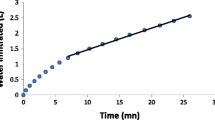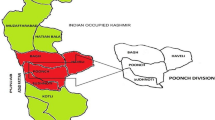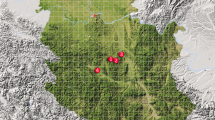Abstract
Experiments were performed in 2D terraria to investigate the burrowing behaviour of different earthworm species from various ecological categories in single- and multi-species assemblages. The burrowing behaviour was quantified using image analysis software during a 2-week period. Terraria were found to reveal realistic impressions of the burrowing behaviour of various species according to the ecological classification of Bouché into epigeic, endogeic and anecic species. Results of the study also permit the recommending of classifying various earthworms as intermediate species, e.g. Aporrectodea longa as endo-anecic and Lumbricus rubellus as epi-endogeic. Burrowing activity of endogeic species was significantly reduced in multi-species compositions compared to single-species treatments. Moreover, burrowing activity of Octolasion tyrtaeum was significantly reduced in the presence of Lumbricus terrestris compared to the specific single treatment. This endogeic species profited from the burrowing behaviour, e.g. bioturbation, of L. terrestris, and as such this is circumstantial evidence for commensalism (species interaction, in which one partner benefits while the other is unaffected) between anecic and endogeic earthworm species. Simultaneous burrowing activity of a combined assemblage of both endogeic species, Aporrectodea caliginosa and O. tyrtaeum, was also significantly reduced compared with the particular single treatments. Thus, this seems likely to be a response of interspecific competition and trophic niche separation between endogeic species.


Similar content being viewed by others
References
Baker G, Carter P, Barrett V, Hirth J, Mele P, Gourley C (2002) Does the deep-burrowing earthworm, Aporrectodea longa, compete with resident earthworm communities when introduced to pastures in south-eastern Australia? Eur J Soil Biol 38:39–42
Bastardie F, Capowiez Y, de Dreuzy JR, Cluzeau D (2003) X-ray tomographic and hydraulic characterization of burrowing by three earthworm species in repacked soil cores. Appl Soil Ecol 24:3–16
Boag B, Palmer LF, Neilson R, Legg RK, Chambers SJ (1997) Distribution, prevalence and intensity of earthworm populations in arable land and grassland in Scotland. Ann Appl Biol 130:153–165
Bolton PJ, Phillipson J (1976) Burrowing, feeding, egestion and energy budgets of Allolobophora rosea (Savigny) (Lumbricidae). Oecologia 23:225–245
Bouché MB (1977) Strategies Lombriciennes. In: Lohm M, Persson T (eds) Soil organisms as components of ecosystems. Ecol Bull Stockholm 25:122–132
Brown GG, Doube BM (2004) Functional interactions between earthworms, microorganisms, organic matter, and plants. In: Edwards CA (ed) Earthworm ecology, 2nd edn. CRC, Boca Raton, pp 213–239
Butt KR (1998) Interactions between selected earthworm species: a preliminary, laboratory-based study. Appl Soil Ecol 9:75–79
Capowiez Y, Belzunces L (2001) Dynamic study of the burrowing behaviour of Aporrectodea nocturna and Allolobophora chlorotica: interactions between earthworms and spatial avoidance of burrows. Biol Fertil Soils 33:310–316
Coleman DC, Crossley DA Jr, Hendrix PF (2004) Fundamentals of soil ecology, 2nd edn. Elsevier, Burlington
Curry J, Schmidt O (2007) The feeding ecology of earthworms—a review. Pedobiologia 50:463–477
Dunger W (1983) Tiere im Boden, 3rd edn. A. Ziemsen Verlag, Wittenberg Lutherstadt
Eisenhauer N, Marhan S, Scheu S (2008) Assessment of anecic behaviour in selected earthworm species: effects on wheat seed burial, seedling establishment, wheat growth and litter incorporation. Appl Soil Ecol 38:79–82
Evans AC (1947) A method of studying the burrowing activities of earthworms. Ann Mag Nat Hist 14:643–650
Ferrière G (1980) Fonctions des lombriciens. VII. Une méthode d’analyse de la matière organique végétale ingérée. Pedobiologia 20:263–273
Grigoropoulou N, Butt KR, Lowe CN (2008) Effects of adult Lumbricus terrestris on cocoons and hatchlings in Evans’ boxes. Pedobiologia 51:343–349
Jégou D, Hallaire V, Cluzeau D, Tréhen P (1999) Characterization of the burrow system of the earthworms Lumbricus terrestris and Aporrectodea giardi using X-ray computed tomography and image analysis. Biol Fertil Soils 29:314–318
Jégou D, Capowiez Y, Cluzeau D (2001) Interactions between earthworm species in artificial soil cores assessed through the 3D reconstruction of the burrow system. Geoderma 102:123–137
Jégou D, Brunotte J, Rogasik H, Capowiez Y, Diestel H, Schrader S, Cluzeau D (2002) Impact of soil compaction on earthworm burrow systems using X-ray computed tomography: preliminary study. Eur J Soil Biol 38:329–336
Killham K (1994) Soil ecology. Cambridge University Press, Cambridge
Kobel-Lamparski A, Lamparski F (1987) Burrow constructions during the development of Lumbricus badensis individuals. Biol Fertil Soils 3:125–129
Kretzschmar A (1978) Quantification écologique des galeries de lombriciens—techniques et premières estimations. Pedobiologia 18:31–38
Kretzschmar A (1982) Description des galeries de vers de terre et variation saisonnière des résaux (observations en conditions naturelles). Rev Ecol Biol Sol 19:579–591
Kretzschmar A, Aries F (1990) 3D images of natural and experimental earthworm burrow systems. Rev Ecol Biol Sol 27:407–414
Lavelle P (1983) The structure of earthworm communities. In: Satchell JE (ed) Earthworm ecology—from Darwin to vermiculture. Chapman and Hall, London, pp 449–466
Lavelle P (1988) Earthworm activities and the soil system. Biol Fertil Soils 6:237–251
Lavelle P, Spain A (2001) Soil ecology. Kluwer, Dordrecht
Lowe CN, Butt KR (2002) Growth of hatchling earthworms in the presence of adults: interactions in laboratory culture. Biol Fertil Soils 35:204–209
Lowe CN, Butt KR (2003) Influence of food particle size on inter- and intra-specific interactions of Allolobophora chlorotica (Savigny) and Lumbricus terrestris. Pedobiologia 47:574–577
Lowe CN, Butt KR (2005) Culture techniques for soil dwelling earthworms: a review. Pedobiologia 49:401–413
Martin NA (1982) The interaction between organic matter in soil and the burrowing activity of three species of earthworms (Oligochaeta: Lumbricidae). Pedobiologia 24:185–190
Neilson R, Boag B (2003) Feeding preferences of some earthworm species common to upland pastures in Scotland. Pedobiologia 47:1–8
Neilson R, Boag B, Smith M (2000) Earthworm δ15N and δ13C analysis suggest that putative functional classification of earthworms are site-specific and may also indicate habitat diversity. Soil Biol Biochem 32:1035–1061
Schmidt O, Scrimgeour CM, Handley LL (1997) Natural abundance of 15N and 13C in earthworms from a wheat and a wheat-clover field. Soil Biol Biochem 29:1301–1308
Schrader S (1993) Semi-automatic image analysis of earthworm activity in 2D soil sections. Geoderma 56:257–264
Shipitalo MJ, Butt KR (1999) Occupancy and geometrical properties of Lumbricus terrestris L. burrows affecting infiltration. Pedobiologia 43:782–794
Acknowledgments
We would like to thank Susanne Kögel for her valuable help with these experiments. The helpful comments of three anonymous referees are gratefully acknowledged. The study was financially supported by the Deutsche Forschungsgemeinschaft (Graduiertenkolleg 1319).
Author information
Authors and Affiliations
Corresponding author
Rights and permissions
About this article
Cite this article
Felten, D., Emmerling, C. Earthworm burrowing behaviour in 2D terraria with single- and multi-species assemblages. Biol Fertil Soils 45, 789–797 (2009). https://doi.org/10.1007/s00374-009-0393-8
Received:
Revised:
Accepted:
Published:
Issue Date:
DOI: https://doi.org/10.1007/s00374-009-0393-8




